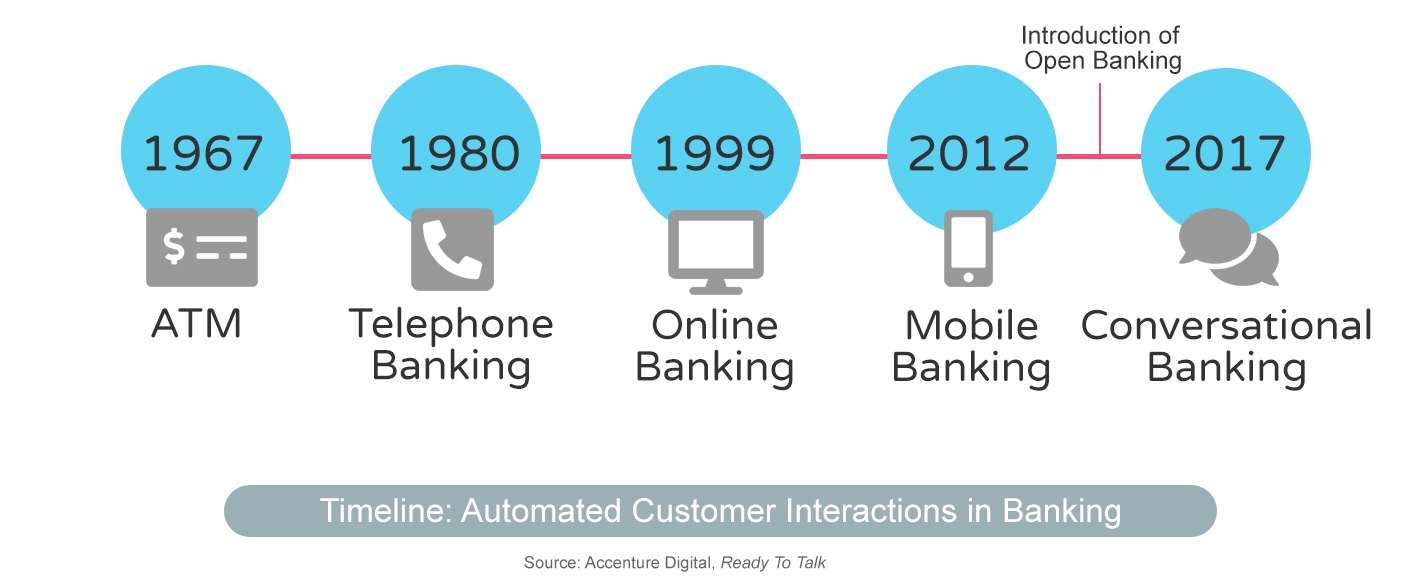
Image from Rawpixel.com
From the IOT to mobile banking, and beyond – a new channel is on the rise and it’s time for banks to get conversational with customers
Advances in the field of artificial intelligence (AI) and machine learning are taking the world of banking and finance by storm; evolving almost as quickly as they are emerging, and shifting the ways consumers interact with companies.
Beyond the debate of using chatbots vs humans for handling queries and support – what the focus should be on now is what’s happening in terms of B2C interactions. All the messaging revolution is forming a new concept for customer contact, based on the most humanly inherent form of communication: Conversation. The conversational trend is spreading across industries and around the world, and the banking sector is no exception.
Banks have come a long way since the waves of disruption caused by the Internet, which led to the revolutionary ways of online banking, and subsequently, mobile banking. Later on, as soon as Conversational User Interfaces (CUI) started to emerge and banks started to adopt them, consumers needed little to no persuasion into using messaging for more direct and friendlier ways to contact their banks. Both text and voice-powered tools that allow the messaging to flow between business and customer have since then been evolving non-stop, with constant growth in usability. This is how analysts are confidently predicting that the future in banking is going in one direction, known as Conversational Banking.

Conversational Banking: What is it?
It’s pretty self-explanatory, but Chatbots Life’s contributing writer, Dharmesh Mistry, has come up with a clear definition for the new paradigm:
“Conversational banking is a bi-directional interface between a customer and a bank, where a conversation can be initiated by either participant through a voice, text or visual interface.” – Dharmesh Mistry, Chatbots Life
A recent report by Accenture looked at key analysis and indicators in the industry, concluding that CUIs are set to dominate the interface and interaction model of digital services used by customers on a daily basis. This report puts Conversational Banking as the primary channel following branches and mobile, which unavoidably creates new challenges for traditional banks and credit unions.
The banking industry is facing a number of issues: the growth of Internet and mobile banking is getting saturated in some countries; customers are demanding more personal interactions; and branch networks are becoming harder to sustain. The emergence of conversational channels are presenting a viable solution to tackle these problems. Conversational banking will represent a more affordable way to interact with customers, it will be easier to implement and maintain, and it has the potential to digitalise and integrate processes in various ways.
From Conversations to a Customer-Centric Experience
The channel of conversations in the context of banking services promises to unify interactions with the power of automation, which can cover areas such as marketing, transactions, customer support, financial advice and more. The integration of these business areas and the force of automation in messaging will allow banks to lay solid foundations for more customer-centric experiences.
The implementation of messaging for banks has a short history; there’s much room for improvement and much more for exploration, but recent case studies and applications clearly show how the implementation drives quick results. The main driver for success is the fact that consumers are preferring messaging platforms over other channels for customer contact. Most firms who have used messaging as a contact channel, mostly for support queries, have experienced the welcoming approach and quick adoption from their user or customer base.
Next steps should revolve around putting messaging at the centre of the customer journey, and not just support – so that business areas work together as a whole, rather than in silos. Banking agents should make the most of the technology to become more capable to deliver a customer-centric experience, using automation as the main enabler for digital interaction and timed messaging throughout the funnel, which will be key to master omni-channel communication.
What actions can banks take to get conversational?
Make live chat a primary touchpoint
Probably the easiest way to get on the first layer of conversational banking is implementing live chat throughout all digital platforms: website, online banking or customer portal, mobile applications and any other user interface where the channel can easily prove to be useful.
Live chat is incredibly easy to implement, and consumers are quick to jump on the chance to use it. With over 64% of consumers choosing messaging platforms over email and phone calls, there is little excuse for banks not to have live chat available for their users to get in touch.
Use chatbots to assist your agents
Adopting AI tools such as chatbots and messaging automation is another logical step in the conversational movement. Virtual assistants or robo-advisors are big in banking; they are helping thousands of banking agents to handle customer queries on a regular basis, such as providing account balance or giving assistance with transactions. With the advances in machine learning, we can see how chatbots will continue to evolve and sooner than later will be handling more complex tasks.
The major advantage of chatbots is that they give banks and financial institutions a channel that operates 24/7 support for their customers. These tools can take care of banking users when agents or representatives are unavailable or offline.
New tech that goes hand-in-hand with messaging
Beyond the basic steps to use live chat and automations, more recent technologies like co-browsing have the potential to revolutionise interactions between banks and customers, taking the conversational approach to the next level.
Co-browsing allows agents to navigate on a website alongside current or prospective customers to guide them through banking processes or applications, accompanied by messaging to communicate with ease and provide a high-level of assistance.
With features like dual cursor and annotations on the screen, agents in the banking industry can find co-browsing software to be an incredibly useful tool that is easy to use, low-friction, and much valued by customers who require more visual and pro-active support in any step of the journey.
Protect users with open banking technology
Open-banking is another technology that can work hand-in-hand with messaging and chat automation, to take conversational banking to the next level and enhance customer experience. One of the great benefits of using open-banking is that it can streamline processes for companies, while protecting customers’ financial data.
The potential of messaging and certain applications in banking services can present some risks to personal data and consumers’ financial information. Banks and credit unions should stay alert and look to implement secure solutions that protect consumer data and privacy.
Some of the latest software solutions for forward-thinking businesses in banking and finance are combining Open Banking technology with messaging tools to streamline the customer journey in banking processes, such as providing bank statements, verifying ID, AML reports and credit checks for applications. Open banking has major advantages when it comes to consumer protection, as the customer is in control of what and when financial data gets shared. The information goes through encrypted and highly regulated processes that are in place for data-sharing via open-banking.
This article originally appeared on Ibby and has been republished with permission.
Business & Finance Articles on Business 2 Community
(68)